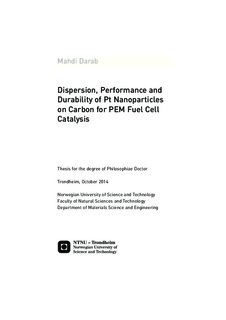| dc.contributor.author | Darab, Mahdi | |
| dc.date.accessioned | 2015-01-21T12:27:08Z | |
| dc.date.available | 2015-01-21T12:27:08Z | |
| dc.date.issued | 2014 | |
| dc.identifier.citation | Public defence 11 December 2014 | nb_NO |
| dc.identifier.isbn | 978-82-326-0508-8 (printed ver.) | |
| dc.identifier.isbn | 978-82-326-0509-5 (electronic ver.) | |
| dc.identifier.issn | 1503-8181 | |
| dc.identifier.uri | http://hdl.handle.net/11250/274479 | |
| dc.description.abstract | The main objective of this work has been to develop the understanding of the effect of Pt particle dispersion on activity and durability of the Pt/C electrocatalysts. In order to have such understanding, extensive testing of the electrocatalysts with different structure ex-situ and in-situ was needed.
The first step was to synthesize the electrocatalysts with desired structural and thus electrochemical features. Wet impregnation and three forms of polyol techniques were used and Pt/C catalysts with isolated and aggregated particles with the flexibility to choose the dominant phase were synthesized. The isolated, aggregated and film-coat Pt nanoparticles on carbon black, carbon nanofiber and carbon nanotube were studied physico-chemically and ex-situ electrochemically. Then three samples, the catalysts with aggregated, with only isolated and with film-coat Pt nanoparticles were tested in a fuel cell before and after an accelerated degradation test (ADT) with N2/harmix and also the exposure to CO.
Isolated particles presented higher ORR activity followed by film-coat and finally aggregated particles. However, the relative durability (the percentage in performance loss upon ADT) had an opposite trend.
The CO tolerance of catalysts with isolated particles was higher than for those with aggregated particles, but recovery of the fuel cell performance after being exposed to CO was slightly higher for catalysts with aggregated particles than for those with isolated particles.
Dynamic electrochemical impedance spectroscopy (dEIS) was only applied to catalysts with aggregated particles, and performance and degradation as a function of cathode catalyst layer (CCL) thickness was only studied for catalysts containing isolated particles only.
dEIS proved to be a convenient tool for investigation of small changes in the electrode, and it was possible to detect changes in electrode performance that would go practically un-detected by cyclic voltammetry and CO stripping.
Electrodes with different thickness based on cathode electrodes with Pt loadings of 10 wt%, 20 wt%, and 30 wt% (containing only isolated Pt particles), were tested in a H2|O2 fuel cell before and after an ADT. The initial electrochemical activity was found to be independent of CCL thickness but in diluted oxygen, the activity was strongly dependent on the CCL thickness or Pt-to-carbon ratio. There was a much larger reduction in cell voltage for the sample with 10 wt% Pt loading comparing with the other two samples that was attributed to the local current density. We suggest that the local current density for this sample crosses a border between two Tafel regimes upon ADT while the 20% and 30% sample remained in the same Tafel regime also after the degradation. | nb_NO |
| dc.language.iso | eng | nb_NO |
| dc.publisher | NTNU | nb_NO |
| dc.relation.ispartofseries | Doctoral theses at NTNU;2014:298 | |
| dc.relation.ispartofseries | IMT-Report;2014:212 | |
| dc.title | Dispersion, Performance and Durability of Pt Nanoparticles on Carbon for PEM Fuel Cell Catalysis | nb_NO |
| dc.type | Doctoral thesis | nb_NO |
| dc.subject.nsi | VDP::Technology: 500::Materials science and engineering: 520 | nb_NO |
